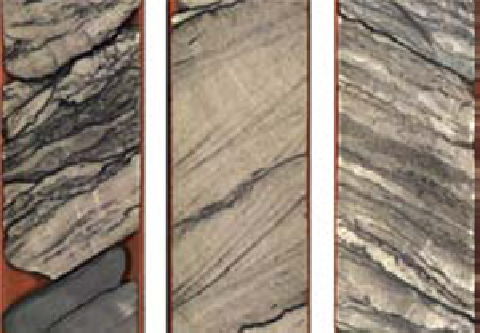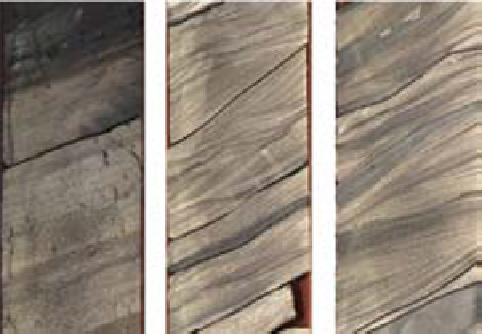Geoscience Reference
In-Depth Information
of facies. Hence a major mouth bar and distribu-
tary channel interpretation is favoured, as was
also suggested by Gjelberg
et al
. (1987) for the
upper part of the Tubåen Formation in the central
Hammerfest Basin.
(A)
(B)
(C)
Nature of the Tubåen fluvial system
Together, the interpreted channels and floodplain
deposits of the Tubåen Formation constitute a
channel-dominated delta plain environment with
some weak marine impact towards the west.
A braided channel interpretation was invoked
for the very sandstone-dominated succession
observed to the east, in wells 7124/3-1 and
7226/11-1 (Figs 8 and 9). The very coarse-grained
nature of the strata in well 7226/11-1, with quartz-
ite pebbles larger than 10 cm, is clearly pointing at
very strong traction currents affecting the chan-
nels and also at deposition in a proximal position
relative to the source area. This may well accord
with a braided type of channel, although sediment
calibre alone is not conclusive as regards the mor-
phology of the fluvial channels (e.g. Miall, 1992).
The better defined fining upwards units seen in
the Hammerfest Basin, coupled with the sporadic
evidence for marine impacts (Fig. 11), may be
interpreted in favour of a more meandering fluvial
style. Commonly, interpreted meandering river
systems have been related to well-defined fining
upwards channel fill successions separated by
fine-grained intervals (Miall, 1992) and the weak
marine influence in the Hammerfest Basin also
suggests that deposition took place in the lower
part of the delta plain, where fluvial channels
typically show a stronger tendency towards mean-
dering patterns (e.g. Collinson, 1996).
From the stratigraphic age assignments (Figs 8
to 10) it appears that fluvial conditions persisted
in the Hammerfest Basin during Rhaetian through
Hettangian times, followed by more marine condi-
tions, with establishment of a wave-dominated
bay and mouth bar systems during the Sinemurian
stage (Fig. 10). However, further to the east (i.e. in
well 7226/11-1, Fig. 9), fluvial conditions seem to
have persisted into the Sinemurian and it can also
be demonstrated from other wells that even
Pliensbachian strata are predominantly fluvial;
for instance in the Nordkapp Basin (e.g. Henriksen
et al
., 2011). Accordingly, the fluvial system seems
to have been most widespread during the
Hettangian, so that the lower part of the Tubåen
Formation represents the regressive maximum of
2757.2 m
2756 m
2746.2 m
(D)
(E)
(F)
Offset well
2710.5 m
2708.5 m
Fig. 11.
Detailed core photographs, Tubåen Formation, well
7121/4-F-2H. (A) sharp-based sandstone bed with abundant
coaly debris; (B) medium-grained sandstone with dm-scale
cross-beds; (C) fine-grained, micaceous sandstone with
small-scale ripple lamination and weak bioturbation;
(D) rooted, silty sandstone below thin coal bed; (E) Wave-
generated ripple lamination; (F) Wave-generated ripple
lamination with low-angle cross-lamination (micro-
hummocky). Core width is app. 12 cm.
The sedimentary features in the CU-unit cap-
ping the Tubåen Formation seem to record the
establishment of a wave-dominated embayment.
The observed wave-ripple lamination (Fig. 11E
and F) is indicative of relatively strong and persis-
tent wave activity in the lower (deeper) part of the
embayment. Furthermore, the observed 35 m
thickness of the CU-unit indicates an initial water
depth exceeding some tens of metres, thus point-
ing towards a relatively large and deep embay-
ment. The upper part of the CU-unit seems to
record a gradual shallowing upwards succession


Search WWH ::

Custom Search